Inside Detroit’s New $950M Innovation Hub
How an historic book depository became the heart of an adaptive reuse project.
The partnership between Newlab and Ford Motor Co. in Detroit looks like a puzzle in which all the pieces fit perfectly together. The two entities are breathing new life into one of the city’s most iconic buildings—the Book Depository near Michigan Central Station—located in an area that has a significant meaning for the U.S. industrial history.
Initially known as the Roosevelt Annex, and later the Roosevelt Warehouse, the building was completed in 1936, serving as a post office branch that handled mail that came by rail. After Detroit Public Schools acquired the building in 1961, the building was renamed The Book Depository and used for book storage. In the decades that followed, the property went through several stages of vacancy, with parts of it destroyed by fire in 1987, ultimately becoming a target for demolition.
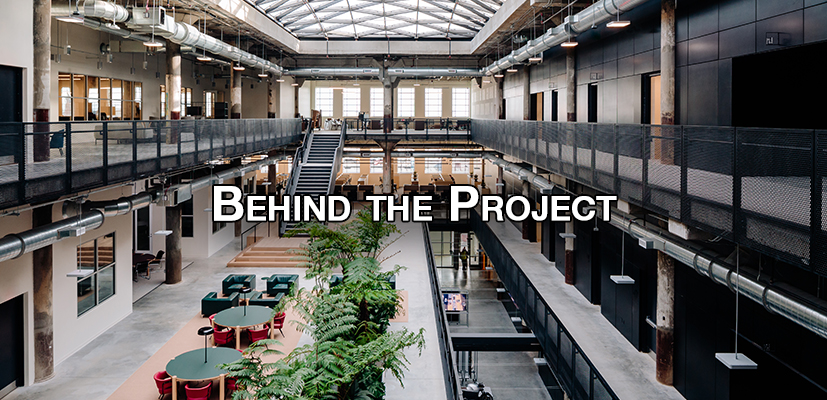
The Art Deco landmark now houses Newlab’s Detroit headquarters. Image by Brian W. Ferry, courtesy of CIVILIAN
But brighter days were on the horizon for The Book Depository. In 2018, Ford Motor Co. acquired the building, along with Michigan Central Station. Two years later, the company unveiled plans for a 1.2 million-square-foot “mobility innovation center” at the site, an investment valued at $950 million. The project centered around four adjacent buildings: The Michigan Central Station itself, The Book Depository, Building West—a new construction—and The Factory, a repurposed former hosiery factory.
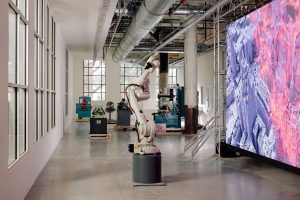
Ford Motor Co. unveiled plans for the transformation of the former Book Depository in 2020. Image by Brian W. Ferry, courtesy of CIVILIAN
As part of the first phase of the project, Ford began the transformation of The Book Depository in 2021, with work completed this year in April. Dubbed Newlab at Michigan Central, the building now houses the Detroit headquarters of Newlab, the innovation company focused on next-generation solutions in mobility, founded by real estate developer Belt.
The building now encompasses 270,000 square feet and features 2,000 square feet of exhibition space, a 200-seat event space, an 11,000-square-foot robotics and prototyping facility, two open studio spaces with desks, lounge spaces, classrooms, as well as meeting and conference rooms.
READ ALSO: Corporate Relocations Are Up, But Experts Paint a Complex Picture
For this adaptive-reuse project to take shape, Ford Motor Co. and Newlab brought together an architectural team that had the ambitious task to repurpose a historical building for the needs of the 21st century user. One of the companies involved in the project was CIVILIAN, a New York-based firm that acted as architectural design consultant, overseeing the interior design for Newlab at Michigan Central. Previously, CIVILIAN collaborated with Newlab for its office spaces at Brooklyn Navy Yard and at 77 Washington St.
In an interview with Commercial Property Executive, CIVILIAN Co-Founder & Principal Nicko Elliott expanded on what it meant to bridge the gap between the past and the present to repurpose a space with such rich history.
What was the vision behind the adaptive reuse of Newlab at Michigan Central?

The interior architects created a mix of private offices, open studios and lounges on every floor of the building, according to Elliott. Image courtesy of CIVILIAN
Elliott: Our goal was to work in dialogue with the existing Albert Kahn-designed building and the corporate modernist design heritage of the region. We wanted to develop a design language that pays tribute to the building’s history while modernizing the space to celebrate the groundbreaking work done by the engineers, designers and entrepreneurs that now occupy its collaborative workspaces.
Tell us more about the team behind the redevelopment.
Elliott: We were really fortunate to work with an incredible group of partners on this project. First and foremost, it would be the whole team at Michigan Central who had the vision to create the growing innovation district of which Newlab is the first phase. Newlab came in to oversee the space and bring in their relationships and expertise within the startup community to bring in a diverse and exciting group of companies to the space.
On the design side, Gensler is the architect of record who oversaw the renovation of the core and shell of this historic building. Michigan-based firm Ghafari was our close collaborator as the interior architect of record. DBI Projects acted as Newlab’s owner’s rep, as well as the project managers at Ford Land.
Why was it important to you to keep some of the building’s original elements intact? What practical reasons influenced this decision, beyond aesthetics and historical preservation?
Elliott: Albert Kahn was an incredibly prolific and pioneering architect whose influence is so deeply felt throughout Detroit, and much of the American Midwest. His industrial buildings were admired for their rationally proportioned structures, lack of ornamentation, straightforward material expression, and oversized windows. All these features were in the design of the Book Depository so we were lucky to inherit a building that is uniquely well-suited to the type of work that is being done by the companies at Newlab.
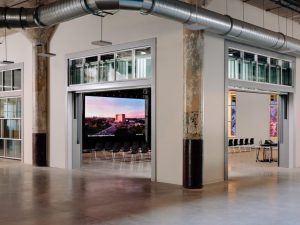
The extensive shell of the building has been preserved, but now it incorporates more expansive spaces. Image by Brian. W. Ferry, courtesy of CIVILIAN
Architecturally, the building has been updated to create more expansive spaces but much of the existing shell has been carefully preserved. Its brick façade, heavily patinated concrete interior and grid of martini cap columns informed the spatial and material sensibility for the project. It was our job as interior architects to develop a floorplan that fostered both visual and programmatic connections between the production and workspaces, and to design a space that inspired collaboration and connection.
The building is an Art Deco landmark. How did you bridge the gap between its original features and the need for a contemporary, modern space?
Elliott: I think we achieved that through a series of interventions that were mindful of the building’s history while creating a contemporary space that supports the needs of the Newlab community.
One example is the event space which is separated from the robotics and prototyping facility by four 20′ x 15′ lift doors inserted to fit between the existing columns. These allow for a porous connection between two very critical but totally different parts of the building. Much of the locally fabricated custom pieces we designed—like the rosewood and pressed stainless steel reception desk and ash and laminate furniture— reference Kahn-era design and the influence of Fordist mass production.
We also sourced American design classics from Michigan-based furniture brand MillerKnoll throughout the project.
READ ALSO: We Also Need to Amenitize Industrial. Start With the Break Room
Could you expand on how you created a lucrative work environment?
Elliott: Newlab is a space designed around cross disciplinary collaboration, so for us it was very important to create a mix of private offices, open studios and lounges on every floor of the building.
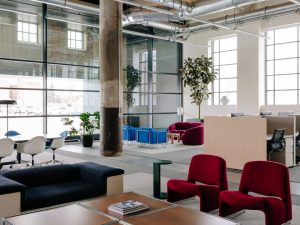
The building is a mix of private offices, open studios and lounges. Image by Brian W. Ferry, courtesy of CIVILIAN
For example, on the ground floor, a cafe serves as a central meeting point for Newlab members and their guests. Given the incredible proportions of the space, we created a year-round interior tree-fern park with lounge seating and worktables in the double-height atrium. It’s a space that we hope fosters a sense of connection and wellbeing.
CIVILIAN’s portfolio spans various project types, including commercial and residential spaces, with three projects already completed this year. What other projects are you working on?
Elliott: We are currently in the final phases of designing an office for a New York-based documentary film studio, a major live-work residential project for an artist in Queens, and the design of our first project in Los Angeles.
How do you envision the future of the adaptive-reuse trend going forward?
Elliott: There are so many successful case studies that show us the power of giving historic buildings a new life. I think what Newlab shows us is the importance of creating buildings that are not only flexible enough to adapt to today’s needs but also those of the future.






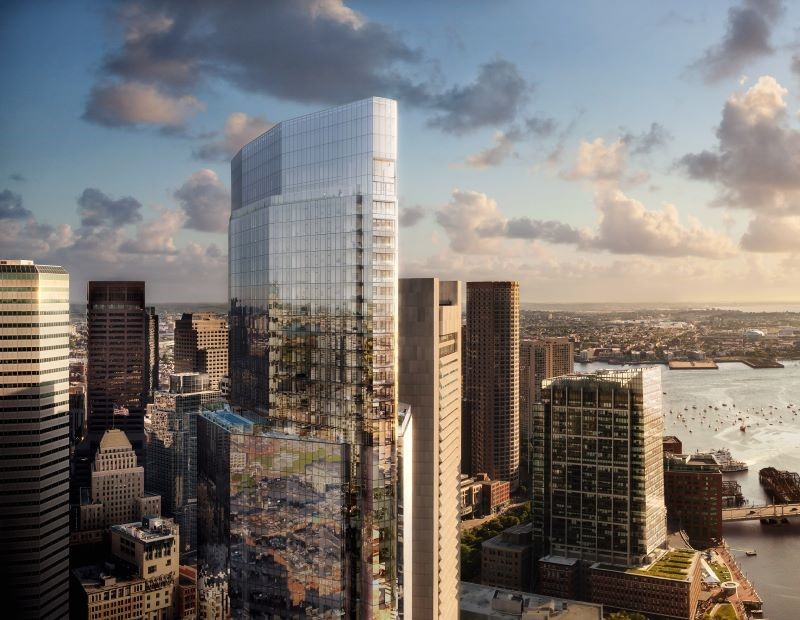
You must be logged in to post a comment.